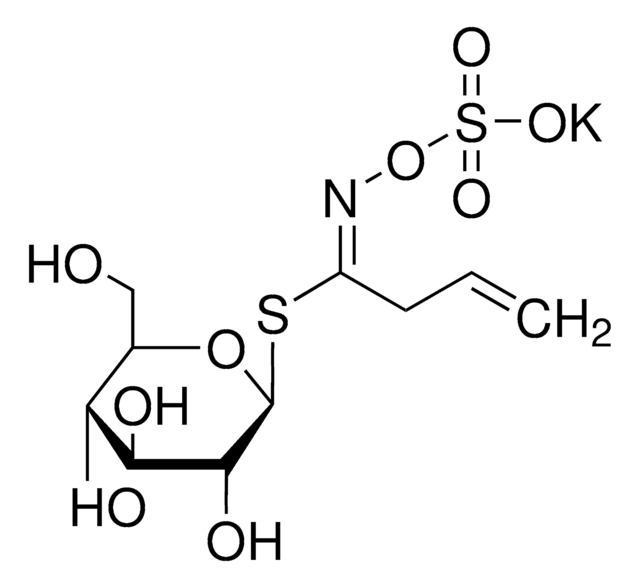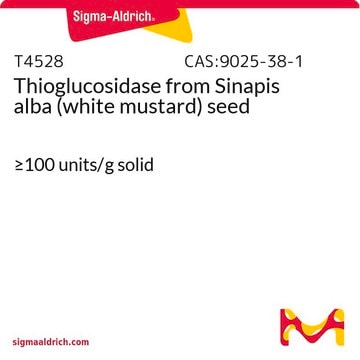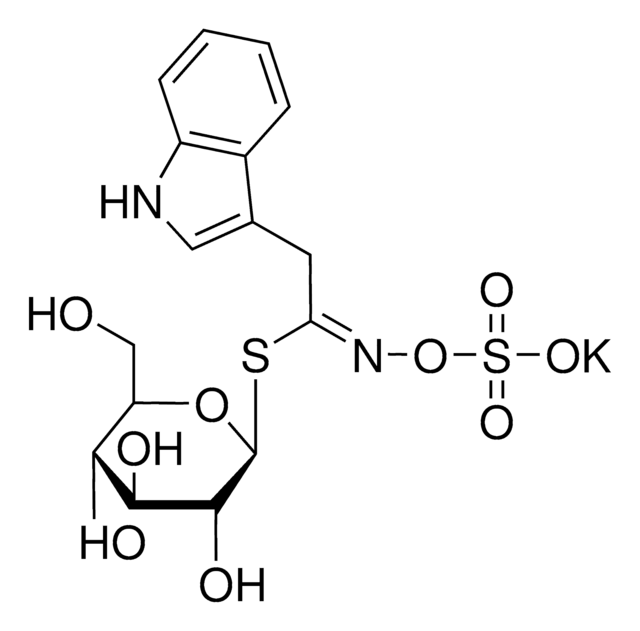S1647
(−)-Sinigrin hydrate
≥98% (HPLC), from horseradish
About This Item
Produtos recomendados
fonte biológica
horseradish
Ensaio
≥98% (HPLC)
Formulário
powder
técnica(s)
HPLC: suitable
cor
white
pf
128 (dec.) (lit.)
solubilidade
water: 50 mg/mL, clear, colorless to faintly yellow
traços de cátion
K: 8.4-10.8% (anhydrous)
temperatura de armazenamento
room temp
cadeia de caracteres SMILES
[K+].[H]O[H].OC[C@H]1O[C@@H](S\C(CC=C)=N\OS([O-])(=O)=O)[C@H](O)[C@@H](O)[C@@H]1O
InChI
1S/C10H17NO9S2.K.H2O/c1-2-3-6(11-20-22(16,17)18)21-10-9(15)8(14)7(13)5(4-12)19-10;;/h2,5,7-10,12-15H,1,3-4H2,(H,16,17,18);;1H2/q;+1;/p-1/b11-6+;;/t5-,7-,8+,9-,10+;;/m1../s1
chave InChI
IUBVMJHASFBYGW-WBMBWNLZSA-M
Procurando produtos similares? Visita Guia de comparação de produtos
Ações bioquímicas/fisiológicas
Outras notas
produto relacionado
Palavra indicadora
Warning
Frases de perigo
Declarações de precaução
Classificações de perigo
Skin Sens. 1
Código de classe de armazenamento
11 - Combustible Solids
Classe de risco de água (WGK)
WGK 3
Ponto de fulgor (°F)
Not applicable
Ponto de fulgor (°C)
Not applicable
Equipamento de proteção individual
Eyeshields, Gloves, type N95 (US)
Escolha uma das versões mais recentes:
Certificados de análise (COA)
Não está vendo a versão correta?
Se precisar de uma versão específica, você pode procurar um certificado específico pelo número do lote ou da remessa.
Já possui este produto?
Encontre a documentação dos produtos que você adquiriu recentemente na biblioteca de documentos.
Os clientes também visualizaram
Active Filters
Nossa equipe de cientistas tem experiência em todas as áreas de pesquisa, incluindo Life Sciences, ciência de materiais, síntese química, cromatografia, química analítica e muitas outras.
Entre em contato com a assistência técnica










